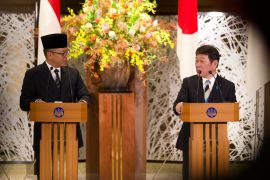Several foreign tourists are not only drawn to the cultural and natural tourism in Japan, but one of the popularly undertaken tours is also to explore spiritual tourism.
One of the spiritual attractions that tourists can explore while vacationing in Japan is Zenkoji Temple, which is one of the most important temples in Japan.
Located in the Nagano Prefecture, Zenkoji Temple has a history spanning 1,400 years.
This temple had received the first Buddha Statue brought to Japan from India via the Korean Peninsula and China.

Built 1,710 years ago, Zenkoji Temple is still a popular place to visit not only for Buddhists but also for tourists in general.
"Anyone can come here. Even if they belong to different religions or sects, it does not matter," Special Guide Yokoyama stated when ANTARA had the opportunity to visit the shrine during the Japan-Indonesia Exchange for Young Journalists Program on February 15-21, 2023.
Zenkoji Temple receives an average of one thousand visits per day. On major holidays, the number of visits to this place can reach over a thousand per day.
Main hall
Out of the several buildings in the shrine is the main hall that has been rebuilt several times due to fires.
No one knows exactly when the main hall was built, as several of the archives were lost to fire. However, the main hall that stands today was built 310 years ago.
Within the main hall were several divine statues. The hall is where the first Buddha Statue was placed.
The Buddha statue, named Ikkosanzon-Amidanyorai, was brought to Japan in 552.
The statue was brought from India via the Korean peninsula as well as China. This statue is the oldest Buddha statue in Japan.
The Buddha statue placed in the main hall of Zenkoji Temple cannot be seen by anyone, including the main priest. This is since the statue is considered to be very sacred.
When visitors enter the main hall, they are asked to remove their sandals or shoes and hats for those who wear it.
Visitors are also prohibited from taking any photos while in the main hall.
After entering the main room in the main hall, on the left side of the room is a curtain depicting a dragon.
Far below the curtain is the room where the first Buddha statue was placed.
The room is closed with a key. Anyone who touches the key during their journey underground is considered to be able to enter heaven.
Underground tour
Apart from being able to enjoy views of temple buildings dating back thousands of years, visitors to Zenkoji Temple can also undertake an underground tour.
During the tour, visitors will go through a 45-meter dark, dimly-lit tunnel.
While entering the dark hallway, visitors will be urged to hold their luggage in their left hand while using their right hand to hold onto the dark hallway wall.
The path followed during the underground tour passes through a section of the chamber where the Buddha Statue is housed.
The room is closed with a key, and anyone who can touch that key during the tour is considered to be able to go to heaven.

Apart from going through the room where the Buddha statue is placed, visitors will also pass through a mirror during the tour.
After passing through the mirror, lucky visitors are said to be able to experience the taste of reincarnation.
"The expression on their face may be different from that before entering the hall," Yokoyama stated.
After passing through a dark alley, visitors will exit the hall and come across another mirror. In the mirror, visitors can compare how their faces appeared before and after taking a tour of the underground.
Yokoyama said the official underground tour was for individual tours.
An individual tour through the dark passages underground is likened to someone entering the body of the Buddha.
Touring through the dark alleys is to enhance the five senses of man.
Another goal is for visitors to feel what people with disabilities sense.
"When it is dark, it is hard for us to hear something, so the five senses can be enhanced. Visitors can also feel what people with disabilities feel," Yokoyama stated.
Sanmon Gate
Before entering the main hall of Zenkoji Temple, visitors will pass through Sanmon Gate.
The gate was founded in 1750. Above the gate is an inscription that reads "Zenkoji".

Although the number five is an odd number, it is considered to be a lucky number for anyone who can find the shape behind Zenkoji's writing.
After visiting the main hall and exiting through the Sanmon Gate, visitors can shop and buy souvenirs along the road inside the temple.

Dozens of shops are also lined up selling knick-knacks and special foods only found in that temple.
Related news: Japan's tourism recovery after COVID-19
Related news: Increase tourism visits to Japan through digital technology: JTB Corp
Editor: Rahmad Nasution
Copyright © ANTARA 2023












